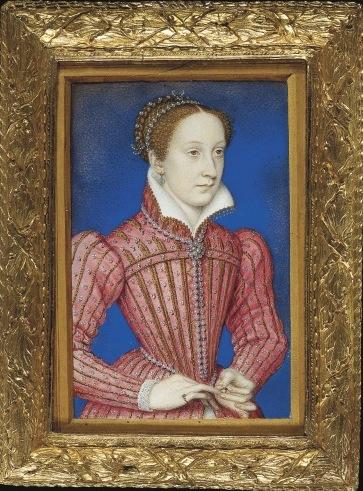
Mary, Queen of Scots, Clouet. Photo: The Royal Collection.
At nine o clock in the morning of the 19th of August 1561, two magnificent galleys, one white and one red and both displaying blue flags proudly emblazoned with the arms of France, arrived into the fog swathed harbour at Leith, Scotland, having made the 600 mile journey from Calais in France. Their arrival threw the town into something of an uproar as they were not expected until much later in the day but unexpectedly fair winds had hastened the galleys’ voyage and so everyone had to make the best of it.
As the curious locals crept closer, they would have seen that the ships were hives of activity as trunks and chests were brought up from below and beautifully dressed people, chattering together in French gathered together and prepared to descend. In their midst was a tall young woman with curling auburn hair, fine hazel eyes and a majestic mien, who probably peered through the thick fog with a mixture of exasperation, apprehension and perhaps even amusement. Mary, Queen of Scotland had not entirely wanted to make this intrepid journey to Scotland but it seems to have been in her nature to laugh and find the funny side of a situation rather than immediately descend into the petulant rage that her Tudor cousins were seemingly so prone to. However, it would also have been on her mind that her companions, used to the well ordered etiquette and luxuries of the French court may well be rather less than impressed by their welcome at Leith and the merest suggestion of any tittering behind their perfumed white hands would have been enough to get her proud Stuart blood up. She may have been absent from Scotland for thirteen years, but that didn’t mean that she was not defensive about it.
However, it did not take long for word to spread of the Queen’s early arrival on their shores and soon Mary was accorded with just the sort of welcome that she had most hoped for with rousing cheers on all sides, bonfires lit in the streets and smiling faces everywhere that she looked. Her French companions may well have muttered about the rough manners of their Scottish hosts, the scragginess of the horses provided for them and the inedibility of the food but as far as Mary was concerned, there was very little cause for complaint so long as her people were genuinely pleased to have her back.
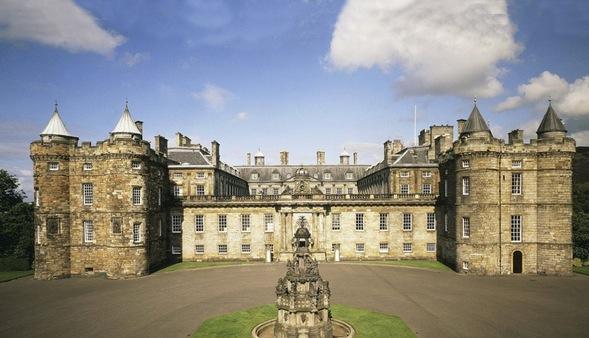
Holyroodhouse. Photo: The Royal Collection.
A deputation of noblemen, including her half brother, Lord James Stewart, escorted Mary and her entourage to the palace of Holyroodhouse on the outskirts of Edinburgh, which she must have been delighted to see had a touch of French style about it. The palace had originally been conceived by her grandfather, James IV who had decided to convert the royal apartments at Holyrood Abbey into a residence worthy of himself and his prospective wife, Margaret Tudor who were eventually married there in August 1503.
After his death, the palace was more extensively renovated by their son, James V who intended it to be his main residence and added a tower, elegant reception rooms and a new chapel. Much of the work was done in anticipation of his marriage to Madeleine de Valois, the sickly favourite daughter of François I, which explains the French styling of the exterior as he employed several French masons. Sadly, the lovely Madeleine, so adored by her husband and father, died in July 1537 at the age of just sixteen and only forty days after her arrival in Scotland. She was laid to rest in Holyrood Abbey and less than a year later her widower married again at Holyroodhouse, this time to one of her distant cousins, Marie de Guise.
As she passed over the iron drawbridge that led to Holyroodhouse, Mary must have looked about herself with some satisfaction. True, the palace was seriously lacking the elegance of the magnificent residences that she had known so well in France and could never compete with the likes of Chenonceau, Amboise or Chambord but there was something very pleasing about it nonetheless and she was no doubt already thinking about ways to improve it to her own tastes.
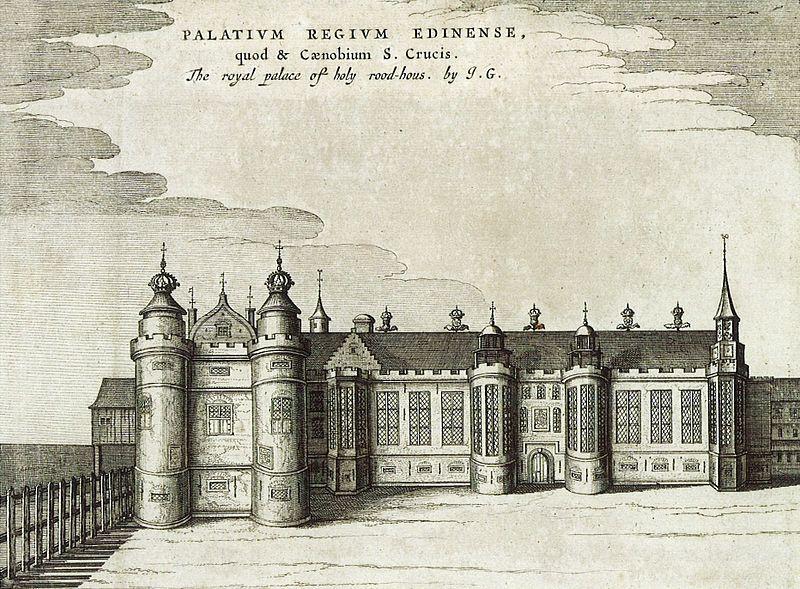
Holyroodhouse as it looked in 1649. It would have looked very similar in Mary’s day.
The royal apartment that was now to be hers was on the second floor of the tower built by her father and was reached by both a small private spiral staircase that led directly to the Queen’s bedchamber from the King’s rooms below and also a spiral staircase from below which opened onto a large Outer Chamber, where the Queen could receive guests and give formal audiences. Later on a small windowed recess at the end of the chamber was converted into a small oratory, where Mary could pray in private.
Beside the Outer Chamber there is the Queen’s bedroom, a large comfortable chamber with wood panelled walls and a compartmented oak ceiling with the initials of James V and Marie de Guise, Mary’s parents. Below this was a new addition, a deep frieze painted with the arms of Scotland and other symbols designed to honour Mary’s arrival in Scotland. Within this room, Mary would have found a magnificently embroidered bed and all the fine furniture that had been there in her parents’ day. Some writers like to imagine that Mary found a scene of damp and squalid disarray but both of her parents had a taste for luxury in their surroundings and no matter what her court thought of her by the end of her reign, when she first arrived in Scotland they were keen to be in her good books so it is very unlikely that they would have furnished her rooms in anything less than the very best taste and comfort.
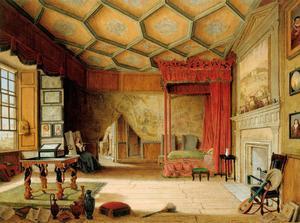
Mary, Queen of Scots’ Bedchamber, S.D Warbreck, 1861. Photo: The Royal Collection.
In the small corner turret beside the room there was the Queen’s private supper room, where she could dine and make merry with her ladies in waiting and closest friends. This was a cosy, cheerful space that would unfortunately later become tinged with tragedy as it was here on the night of the 9th of March 1566 that Mary’s Italian born secretary David Rizzio, who was dining with the Queen and a few of her friends, was dragged away from her by a group of noblemen, led by her estranged husband Lord Darnley who took them up the private staircase from his own rooms which led to Mary’s bedchamber, and then stabbed to death in the Outer Chamber, all within earshot of the terrified Queen, who was pregnant at the time.
Mary was then held captive at the palace by the conspirators but managed to win her husband over and with his assistance escaped to Dunbar Castle and then on to Edinburgh Castle, where their son, James, was born in June. The royal marriage, which had begun with splendid celebrations in the chapel of Holyroodhouse, was effectively at an end however and it was at this point that Mary’s tenure as Queen of Scotland entered its final stage, culminating in her imprisonment and subsequent abdication in 1567.
The sad fate of Mary, Queen of Scots is very well known and for the years immediately after her imprisonment and eventual execution, her memory was reviled in Scotland, with even her own young son being encouraged to think of her as a murderess and adulteress who had been corrupted by her untrammelled feminine passions. However, over time the tide definitely began to turn and Mary, who always had her champions even if they did not dare speak up in her defence, increasingly began to be regarded as a heroine and the tragic victim of overwhelming and sinister machinations. It was at this point that relics of the dead Queen began to be revered and objects and places associated with both her person and her brief yet dramatic reign were regarded with enormous interest.
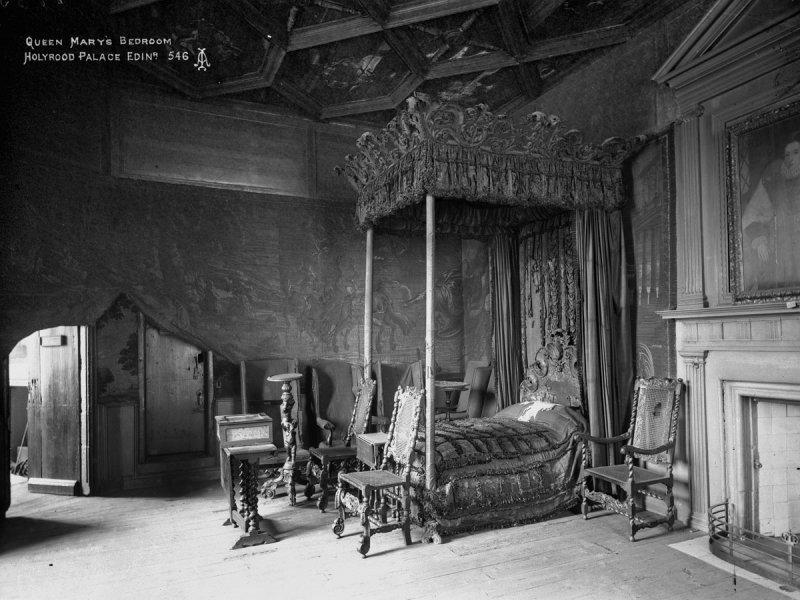
Queen Mary’s room on an old postcard from 1885. This is the romantic yet dishevelled look that Victorian visitors on a Mary Stuart Pilgrimage expected to find.
The former rooms of Mary, Queen of Scots at Holyroodhouse fell into disuse and disrepair after her son left Scotland to be succeed her cousin, Elizabeth I as King of England and when her great grandson, Charles II remodelled the palace (and yet never actually stayed there), they were even more sidelined as he concentrated on creating something in the model of Hampton Court with magnificent new airy rooms, suitable for entertaining on a grand scale, surrounding a central quadrangle. It was not until the end of the eighteenth century when the romantic fascination with Mary reached something of a peak, probably because of the association with Marie Antoinette, another former French Queen who had met a grisly end, that the panelled rooms on the second floor that had seen so much drama began to attract their first visitors intent on seeing where the tragic Queen had lived.
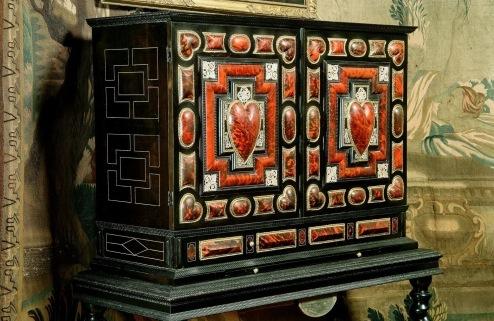
A 17th century cabinet in Queen Mary’s bedchamber. Legend has it that Mary brought this piece with her from France but of course that is impossible. However, it’s a lovely piece with its distinctive heart shaped decoration and so has been allowed to remain. Photo: The Royal Collection.
At this point, the rooms had been taken over by the Duke of Hamilton, who was lodged below and his servants, espying an opportunity, moved his more old fashioned furniture up to the former Queen’s rooms and charged visitors for guided tours full of ghoulish details about Rizzio’s murder and Mary’s brief imprisonment there. It must have been thrilling indeed and we know that in 1820, even George IV paid a private visit to Holyroodhouse and insisted that the Duke’s housekeeper take him on a guided tour of Mary’s rooms. In fact he was so impressed by the experience that he immediately ordered that the palace, which had fallen into immense disrepair should be restored but that ‘these apartments should be preserved, sacred from every alteration‘.
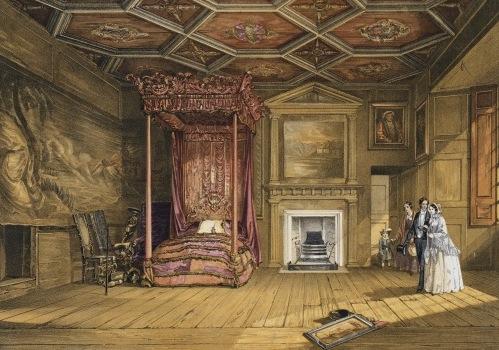
Queen Mary’s Bedchamber, G.M Greig, 1862. Photo: The Royal Collection.
Sir Walter Scott also visited Mary’s apartments at around this time and commented on the crimson state bed as being the ‘couch of the Rose of Scotland’, not realising or simply ignoring the fact that the said couch was actually the seventeenth century bed of one of the Duke of Hamilton’s ancestors and nothing to do with the saintly martyred Queen at all. Nonetheless, this bed, which became increasingly threadbare and tattered, was to remain an integral part of Mary’s rooms and, by extension, legend until the 1970s, becoming more dishevelled and picturesque with each passing decade and taking centre stage in many pictures of the room during this period.
Interest in Mary’s rooms grew immensely throughout the nineteenth century, with even Queen Victoria falling under the dust moted spell of the chambers and, like her uncle, decreeing that they must remain untouched as a sort of shrine to her tragic ancestress. The shabby old furniture of the Duke of Hamilton was now shamelessly passed off as having belonged to Mary herself and for a long time no one really thought to question this with visitors clearly just feeling completely thrilled to tread with their own feet, the floorboards that had once been danced over by Mary Stuart and to see for themselves the very spot where poor David Rizzio had bled to death from over fifty knife wounds. ‘I went… to see Mary Queen of Scots’ Bedchamber (a very small one it is) from whence David Rizzio was drag’d out and stab’d in the ante room where is some of his Blood which they can’t get wash’d out‘ wrote the Duchess of Northumberland with some relish in 1760 and later visitors would be just as enthralled by the romance and tragedy of Mary’s tale.
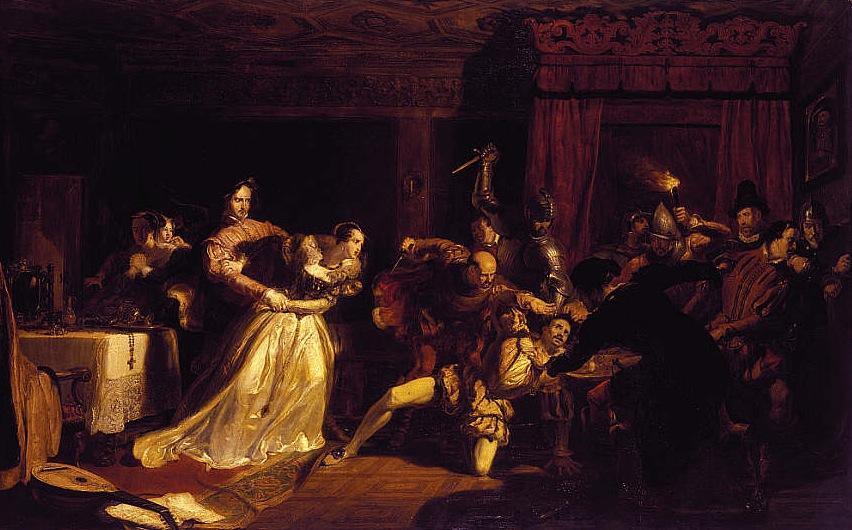
The Murder of David Rizzio, Sir William Allan, 1833. Photo: National Gallery of Scotland. As you can see, the red bed has even managed to appear here in this dramatic depiction of the unfortunate secretary’s assassination as the artist took great care to exactly reproduce Mary’s bedchamber in the painting.
Things began to change in the twentieth century – although the fascination with Mary, Queen of Scots would never wane and, in fact, is still going strong, visitor’s expectations began to change dramatically as more was known about the sixteenth century and it became clear that perhaps the Queen’s chambers weren’t really as authentic as had been assumed. Also, the royal edicts that the rooms be left untouched, which had initially resulted in a charming state of aristocratic decay and a doom laden romantic ambience meant that this was rapidly declining into a state of dank neglect, which was at odds with the desire to create a suitable memorial of Mary’s time at Holyroodhouse and did nothing to evoke the graceful, elegant woman who had once inhabited the chambers and filled them with beautiful objects and paintings.
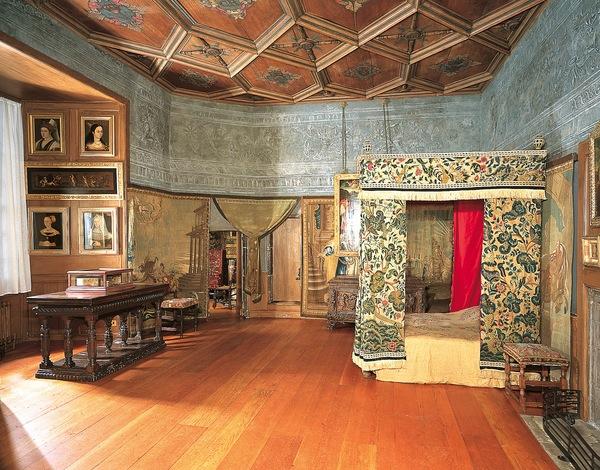
Mary, Queen of Scots’ bedchamber as it looks now. Photo: The Royal Collection.
In the end the decision was made in the 1970s to remove the tatty old furniture and restore it to be put on show elsewhere in the palace and transform Mary’s former rooms to reflect a more accurate representation of how they probably looked during her life time while at the same time retaining the intrinsic ambience that has attracted so many curious visitors over the centuries.
Would Mary walk in now, look around and feel instantly at home? Most probably not but I do like the way that over time our notions of restoring historic buildings have evolved so enormously so that they, their former residents and their current visitors are treated with proper respect.
